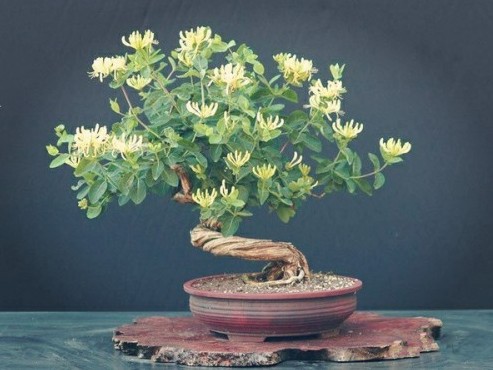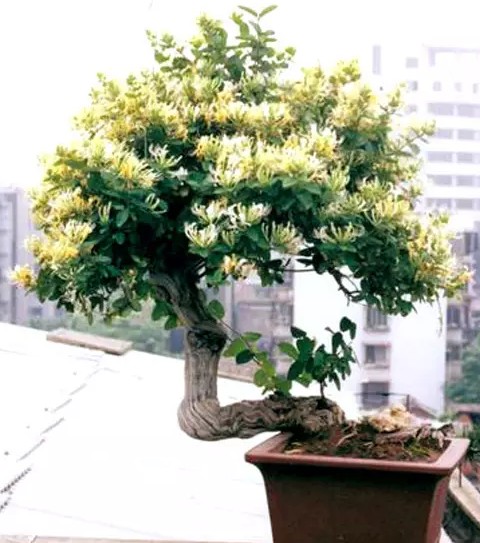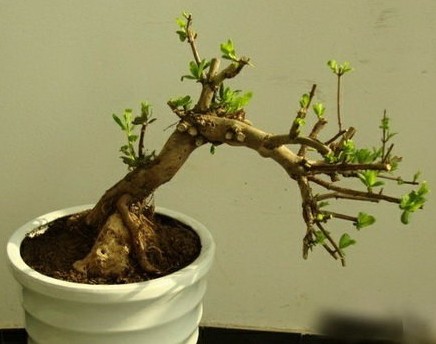Seedling raising technique of Honeysuckle Bonsai
Honeysuckle is used as park hedge, fence, balcony, flower gallery, flower rack and other three-dimensional greening in gardens, as well as ground cover materials for soil and water conservation, wind prevention and sand fixation. Honeysuckle not only can be planted on the ground, but also can be used as a potted ornamental.

There are three culture methods of honeysuckle: seed culture, strip culture and cuttage culture. Cuttage culture is widely used in production. Because this method can maintain the excellent characters of the variety, and can quickly produce a large number of high-quality seedlings.
Seedling raising techniques of Honeysuckle Bonsai:
1. Sowing and reproduction
The ripe fruits were harvested from August to October, the pericarp was washed with clean water, the seeds were harvested and dried, and then stored in a cloth bag at low temperature to the next spring. Sowing seeds from late March to early April, soaking seeds in 25 ℃ warm water for one day before sowing, then mixing wet sand into cloth bags and putting them indoors, heat preservation with rice straw (straw, thatch, etc.). When the seeds of more than 1 stroke 3 are exposed, they are sown in loose, fertile and well-drained sandy soil, and seedlings can emerge about 10 days after sowing. It was transplanted to the nursery in the spring of the following year and was generally cultivated in the pot after sowing for 5 years.
2. Cuttage propagation
In the middle and last ten days of June, the full semi-lignified branches of the same year were cut as cuttings, each section was about 15~20cm long, and the bed soil was kept moist. I sprayed the cuttings, and it took about 25 days to take root. It was transplanted to the nursery in the spring of the following year and cultivated in the pot 4 years later.
3. Ramet propagation
In spring and autumn, the seedlings sprouting from the roots of the mother plant were dug up (separated by a sharp knife) and transplanted to the nursery with roots, which could be cultivated in pot for 4 years.
4. Striping propagation
In spring and autumn, take the longer branches of the mother plant, bury them in the soil for about 5cm, deep 2~3cm, keep the soil moist, take root in the same autumn, separate them from the mother plant in the nursery the next spring, and cultivate them in the pot 3 years later; or select the vigorous and elegant branches in the Meiyu season for high pressure, cut off the mother plant and cultivate them in the pot directly after rooting, this method takes faster forming time.
Time: 2019-06-13 Click:
- Prev

Pruning skills of Honeysuckle Bonsai
Honeysuckle is strong in nature, it can take root as soon as the stem hits the ground, and the bare root can be transplanted, and the excavated old pile is easy to survive without fibrous root. From the beginning of pot planting, dwarfing, shaping and pruning was carried out and cultivated into thick, dry and short branches. During the growing period, remove the buds with exuberant growth, pick the hearts of the strong branches early, and keep them short when pruning. By shaping and pruning
- Next

Processing and Modeling Technology of Honeysuckle Bonsai
Honeysuckle is a temperate and subtropical tree species, which is sunny, shade-tolerant, cold-tolerant, drought-tolerant and moisture-tolerant, and can adapt to both acidic and alkaline soil, but likes loose and fertile neutral sandy loam. It has strong nature, developed root system, strong sprouting ability, light plant, graceful posture and elegant old pile.
Related
- Fuxing push coffee new agricultural production and marketing class: lack of small-scale processing plants
- Jujube rice field leisure farm deep ploughing Yilan for five years to create a space for organic food and play
- Nongyu Farm-A trial of organic papaya for brave women with advanced technology
- Four points for attention in the prevention and control of diseases and insect pests of edible fungi
- How to add nutrient solution to Edible Fungi
- Is there any good way to control edible fungus mites?
- Open Inoculation Technology of Edible Fungi
- Is there any clever way to use fertilizer for edible fungus in winter?
- What agents are used to kill the pathogens of edible fungi in the mushroom shed?
- Rapid drying of Edible Fungi

